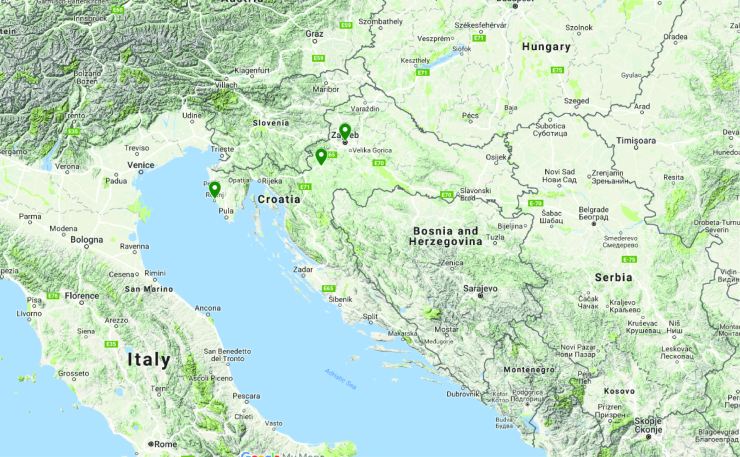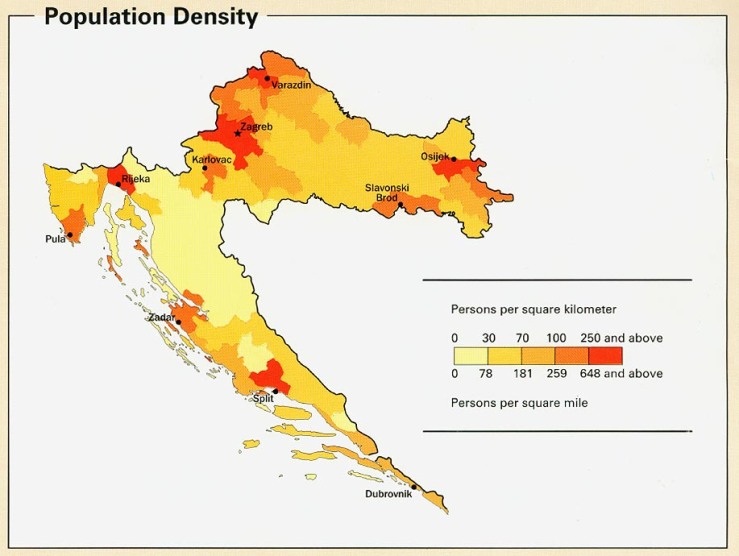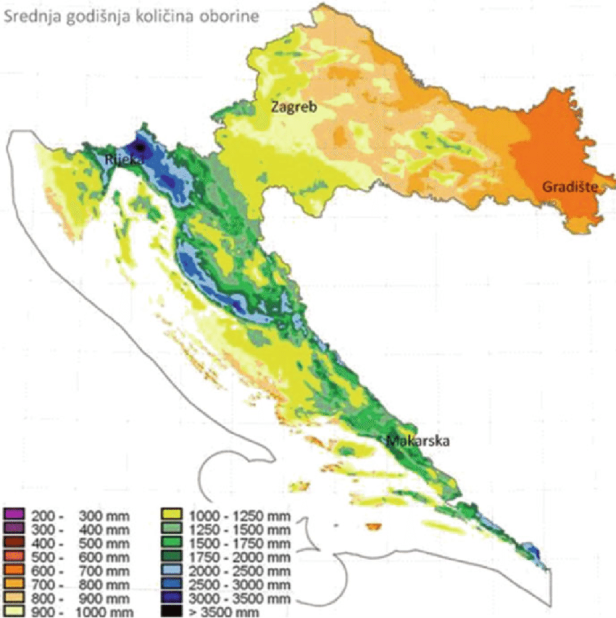During the course of our two week IFE, students traveled to three main locations in Croatia:

Examining the Demographics, Environmental, Market and Governance (DEMG) of an area provides a broader perspective of the region to better understand specific sustainability challenges and finite interrelated factors which influence those challenges. We have summarized the DEMG for Croatia below, in order to better understand the specific case studies we examined when abroad.
Demographic
The Croatian population totals approximately four million individuals, which is overall declining due to a higher death compared to birth rate, and because many people emigrate out of the country for employment opportunities (The World Factbook). The population density is approximately 76 people per square mile, and the population is 48% male, 52% female. In addition, 40% of the population fall into the 25-54 age range (Croatia Population 2018), and the average life expectancy is 76 years old.
The main ethnic group is Croatian (90.4%), while the remainder of the population are Serbian (4.4%) and a mix of ethnicities including Bosniak, Hungarian, Slovene, Czech, and Romani. The majority of the population lives in the northern half of the country, with about 25% living in or around the capital of Zagreb (The World Factbook).

Croatia’s gross domestic product (GDP) is 100.3 billion USD annually, and per capita wealth ranks 28th among European and Asian countries. Despite this statistic, almost 20% of the population is below the poverty line (The World Factbook).
Croatia spends approximately 8% of its GDP on health, and 97% of the population has access to improved sanitation facilities. The adult prevalence rate of HIV/AIDs is less than .1% and the adult prevalence rate of obesity is 24.4%. Croatia also invests approximately 5% of its GDP on education, and 99.3% of the adult population are literate (The World Factbook). However, as mentioned above, the majority of highly educated Croatian natives emigrate out of the country to seek higher paying employment.
Environment
The Croatian climate is relatively constant, although the highlands experience slightly lower temperatures and higher precipitation. The average temperatures are 77°F (25°C) in the summer and 48°F (9°C) in the winter, and average rates of precipitation are 31.9 inches in cities such as Rovinj (Crljenko et al., 2013).

Electricity, oil, and gas are the main sources of energy. In 2016, electricity consumption of Croatia was 18.65 billion kWh, 68% of which is produced within the country. While approximately 40% of this total electricity came from fossil fuels, 45% is produced from hydroelectric plants, and the remaining from other renewable sources (Ardizzon, Cavazzini, and Pavesi, 2014). This production is possible because Croatia is rich in water resources.
The largest rivers in Croatia are River Sava (562 km) and River Drava (505 km). All the rivers and surface water flow into one of two main watersheds, the Black Sea basin (62%) or the Adriatic basin (38%; Crljenko et al., 2013). The mainland coastline of Croatia measures nearly 1,800 km, with the multiple islands and inlets measuring another 4,000 km (The World Factbook). Some of the main threats to the Adriatic Sea and Croatian coast were discussed with a partner from the Center of Marine Research. These threats include eutrophication, hypoxia/anoxia, mucilage events, sewage pollution, hydrocarbons, heavy metals, vessel transport/ballast waters, marine litter, and microplastics.
The majority of the potable water supply comes from underground water sources, with approximately 14% coming from surface water. Of the 3.15 million hectares of agricultural land in Croatia, about 66% is arable land, with the remainder consisting of pastures, ponds, and fish ponds. Farming on the arable is able to cover domestic need for cereals and sugar, and most of the demand for industrial crops. In addition, Croatia is a wine-growing country, with vineyards covering 58,000 hectares of land and in 2011 1.4 million hectoliters of wine produced (Crljenko et al., 2013).
There are more than 23,000 species and subspecies of plants and animals found in Croatia. Some of these species (2.4%) are endemic and 1,600 (8%) are protected. The endemic species are generally found in the rivers and coasts (Crljenko, et al., 2013).
Market
Natural Resources: Croatia doesn’t have large mineral resource reserves. However, there is an abundance of non-metal minerals which contribute to raw material construction material like sand and gravel. The country also extracts large quantities of salt out of the Adriatic Sea. In addition, Croatia has renewable energy resources like solar and wind, and their own natural gas and oil reserves (Crljenko, et al., 2013).
Agriculture and Fisheries: Industrial crops, vineyards, fruits and vegetables, and olive oil trees are the main production uses of the arable land in Croatia. Fisheries extraction in coastal regions totaled 78,000 tons processed in 2011 (Crljenko, et al., 2013).
Industry, Energy, Construction: In 2011, the value of industrial services was approximately 19 billion USD (Crljenko, et al., 2013). Industries such as textiles, leather, metal and timber were historically more successful, though currently industries such as food production and petrochemical industry are profitable. The most common export activities are related to the processing of oil products (11.8%), motor vehicles (11.2%), chemical products (8.3%), food production (8.1%), electrical equipment (7.8%), machinery (6.2%), finished metal products (6.1%), pharmaceutical products (4.8%), clothing (2.9%), and timber and wood products (3.4%).
Services, Trade, Transport: As a result of increased European Union (EU) funds over the last decade, Croatia’s network for roads and transport has become more modern. Shipping lines and ferries also connect Croatian waterways with countries along the Adriatic Sea. Along this coast, there are over 350 ports and docks used for industry, trade, and other services, such as Pula, Rijeka, Zadar, Sibenik, Split, Ploce, and Dubrovnik. In terms of foreign trade, Croatia imports twice as many products as it exports, with the main trade partners including Bosnia and Herzegovina, Austria, Italy, Germany, Slovenia, the UK, Serbia, Hungary and Russia (Crljenko, et al., 2013).
Tourism: Croatia is a country that has a large portion of its GDP generated by tourism, approximately 14%. This trend has continued to rise over the past few years, especially during the summer months. Coastal counties bring in a majority of the foreign tourists, and account for approximately 96% of the tourist nights spent in the country compared to 4% of the continental counties (Crljenko,et al., 2013).
According to the Mayor of Rovinj, there are some environmental risks that could impact tourism along the Adriatic coast. Toxic chemical or waste spills can impact beaches and therefore the entire region relying on tourism as a main service. Industrial waste flowing through the Adriatic Sea from Italy and other more industrialized nations is also a concern.
Supply Chain & Risks: There are several large companies under private ownership which play a significant role in foreign trade, many of them being significant technological innovators. These include large food and industrial producers. Public companies mainly in the fields of transport, energy and municipal utilities, and for the management of natural resources, are under state ownership, or in mixed ownership under state control. These include entities like Croatian Waters, and electric companies (Crljenko, et al., 2013).
Governance
Croatia has multiple levels of governance, ranging from national leadership to local municipalities. On the national level, Croatian government is divided into three branches- the executive, legislative, and judiciary (Crljenko, et al., 2013). The legislative branch is composed of the Parliament, or Sabor, consisting of a representative house who belong to a specific political party. The executive branch is composed of the President and Government consisting of 20 Ministries, which includes the Ministry of Energy and Environmental Protection. The judiciary branch consists of the courts, who are independent. On the regional level, Croatia is divided into 20 counties and 1 city county of Zagreb (Crljenko, et al., 2013). Each county is responsible for general education, health, land use, economic development, transport and infrastructure, and the development of educational and cultural institutions through a lower level of governance (Croatia EU). On the local scale, Croatia has hundreds of towns and municipalities that consist of self-governing units which are established through population. Croatia was formerly under a socialist regime, but has since transformed into a democratic society after becoming independent and joining the EU (Crljenko, et al., 2013).
According to the Council on Foundations (Croatia), Croatia is a civil law country with three primary forms of not-for-profit, nongovernmental organizations (NGOs):
- Associations
- Foundations
- Funds
Cooperation between the Croatian Government and these NGO’s has been key in shaping Croatia into a modern nation (Government). The “Program of Cooperation between the Government of the Republic of Croatia and the Non-For-Profit Sector in the Republic of Croatia” demonstrates that many institutions were established during this time which contributed to increased fiscal activity and public benefit. In the forward, the Cooperation states, “Shaping Croatia into a modern nation has been greatly helped by the endeavor of civic initiatives and various associations of citizens… It is clearly so that a part of wealthier and more educated citizens nurtured the virtue of caring for the problems in the community and of giving for the public benefit.” (Government). These foundations and associations strengthened the Croatia identity during the times of transition into the EU. The initiation of Croatia into the union has allowed the country more opportunities to foster and share its identity and culture with the world.
References
- Ardizzon, G., Cavazzini, G., and Pavesi, G. (2014). A New Generation of Small Hydro and Pumped-hydro Power Plants: Advances and Future Challenges. Renewable and Sustainable Energy Reviews. 31, 746-761
- Crljenko, et al. 2013. “Croatia: Land and People.” The Miroslav Krleža Institute of Lexicography.
- Croatia. (2018). Retrieved from https://www.cof.org/content/croatia
- Croatia EU. (n.d.). Retrieved from http://croatia.eu/index.php?lang=2
- Croatia Population. (2018). Retrieved from http://worldpopulationreview.com/countries/croatia-population
- Croatia Population Density Map – Croatia. (n.d.). Retrieved from http://www.mappery.com/Croatia-Population-Density-Map
- Government of the Republic of Croatia. (n.d.). Retrieved from http://www.icnl.org/research/library/files/Croatia
- Jericevic, A., Ilyin, I., and Vidic, S. (2012). Modelling of Heavy Metals: Study of Impacts Due to Climate Change. NATO Science for Peace and Security Series C: Environmental Security. 125, 175-189.
- The World Factbook: CROATIA. (2018). Retrieved from https://www.cia.gov/library/publications/resources/the-world-factbook/geos/hr.html.
- Image source: https://www.aljazeera.com/news/2018/07/gold-massive-crowd-welcomes-croatian-team-180717085304139.html